The long-awaited? Golden Week has finally arrived.
It seems that the weather will be favorable this year.
Last year, I rode along the Japan Sea side of Yamagata and crossed the dirt roads of the Shirakami Mountains.
This year, I thought it would be nice to ride along the coastline on the Pacific side.
The problem is the route.
During the Golden Weeks of 2020 and 2021, the ongoing COVID-19 pandemic made it difficult to travel between prefectures, and many restaurants couldn’t even operate properly.
However, with vaccination progressing and the realization that if everyone continued to stay at home, the economy and daily life would collapse, this year’s Golden Week finally comes with no movement restrictions.
That said, congestion is expected everywhere.
If I take the major roads that everyone else chooses, I’ll never make any progress.
So, I decided to take narrow roads like prefectural routes to head north.
I set up several checkpoints on the way to the campsite in Aomori Prefecture to plan for refueling and breaks.
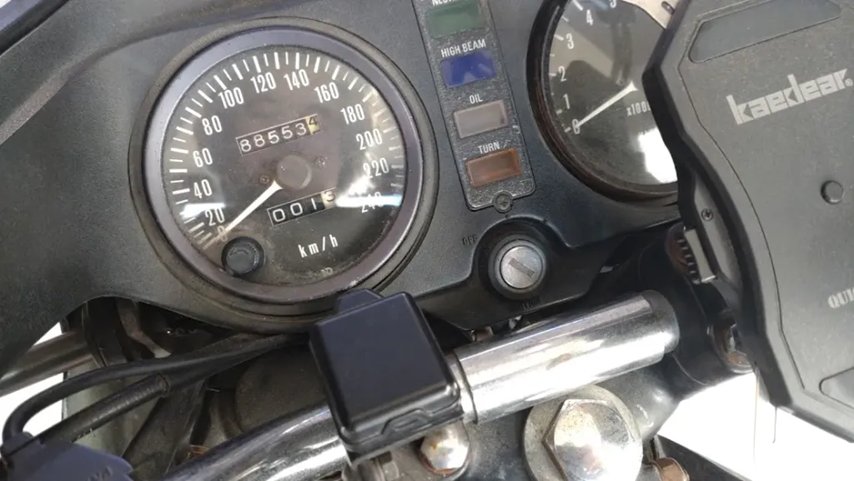
From home to Senmaya, Iwate Prefecture.
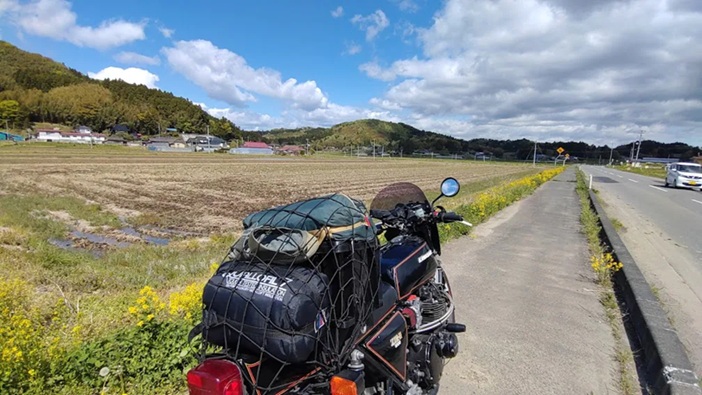
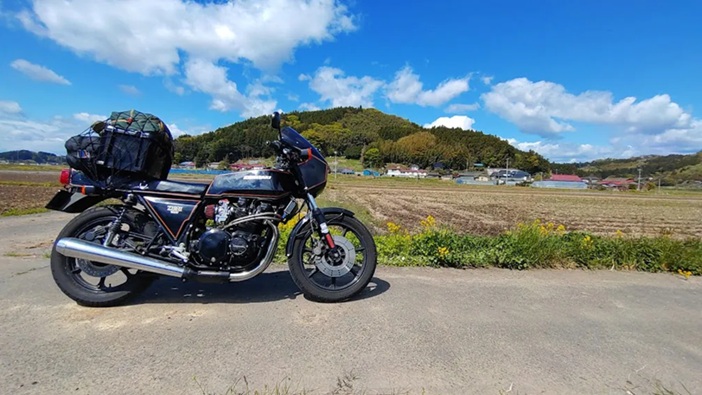
Riding through roads like this.
The cars I saw all over the place while passing through town? Almost none out here.
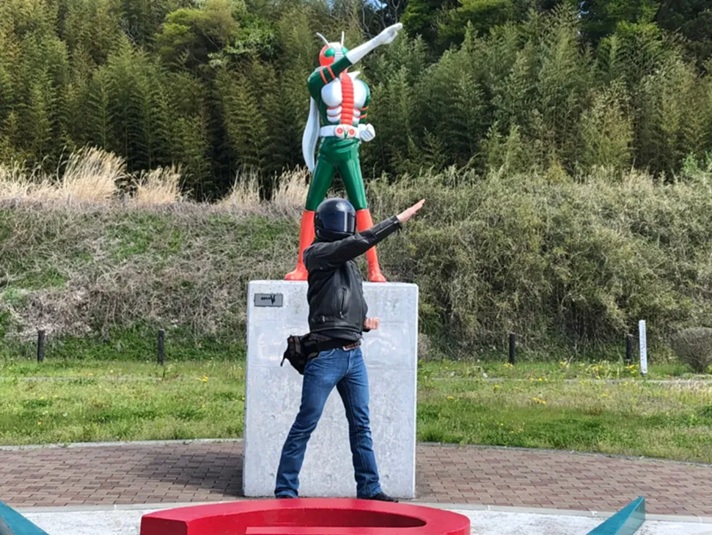
I asked a nearby passerby to snap the photo for me (thanks!).
Right along the route, there’s the Shotaro Ishinomori Memorial Hall – an absolute mecca for die-hard fans. The whole town is dotted with characters from Ishinomori’s works, as if they’re just part of the landscape.
Being Golden Week and all, there was already a line forming from early on.
Made it to Senmaya without a hitch, but while taking a break at the convenience store, I started getting calls from every direction. Lost a good hour just dealing with that (lol).
Little did I know that this lost time would cast a long shadow over the rest of the journey…
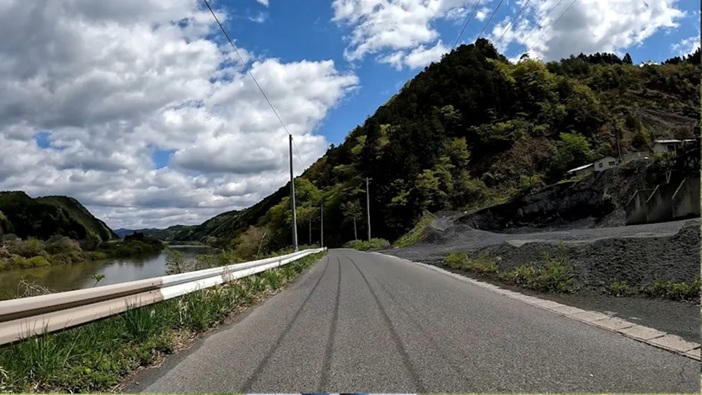
Senmaya to Tono City, Iwate Prefecture.
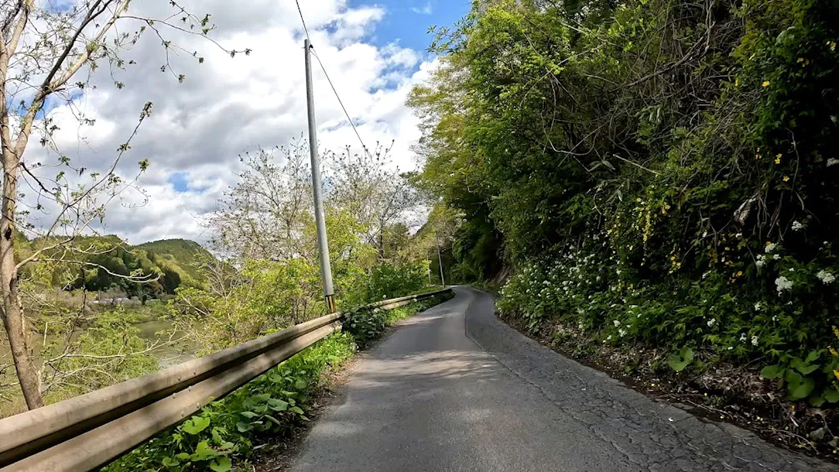
The sun felt pleasantly warm while riding through Senmaya, but the weather started turning sketchy.
By the time I reached Tono just past noon, the rain had picked up.
Hungry and in need of shelter, I took refuge at the “Roadside Station Tono Kaze no Oka” for a quick lunch.
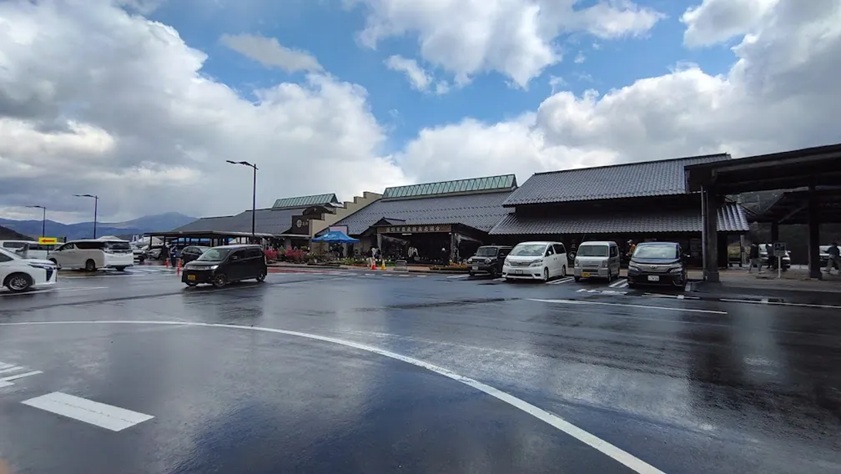
There were brief moments when the sun peeked through, but the rain just kept coming down.
While wandering around the roadside station, it turned into an outright downpour.
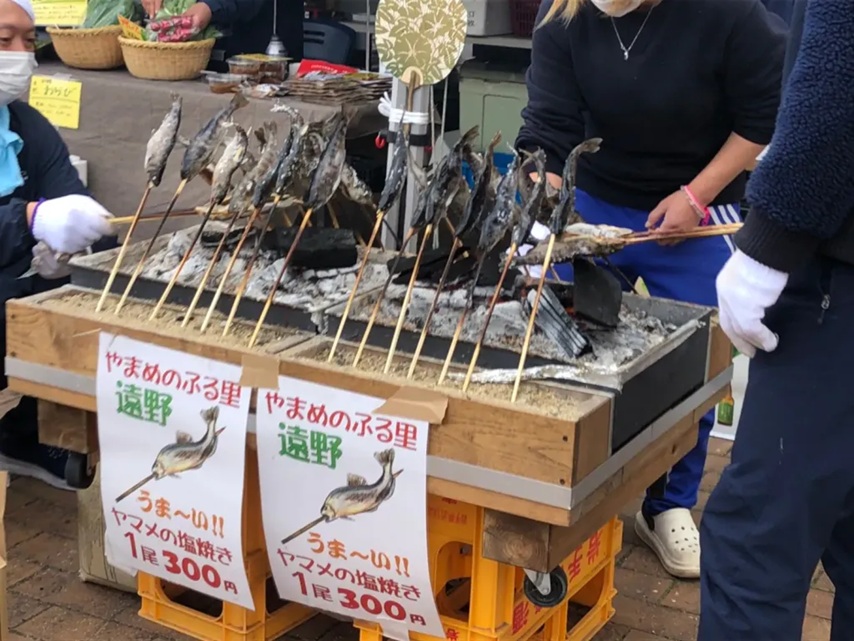
When I first arrived, there were stalls grilling fish, oysters, and whelks – and I thought, “Oh, nice!”
But just then, the rain started pouring like crazy.
By that time, it was so cold I couldn’t stop shivering, so I decided to eat indoors.
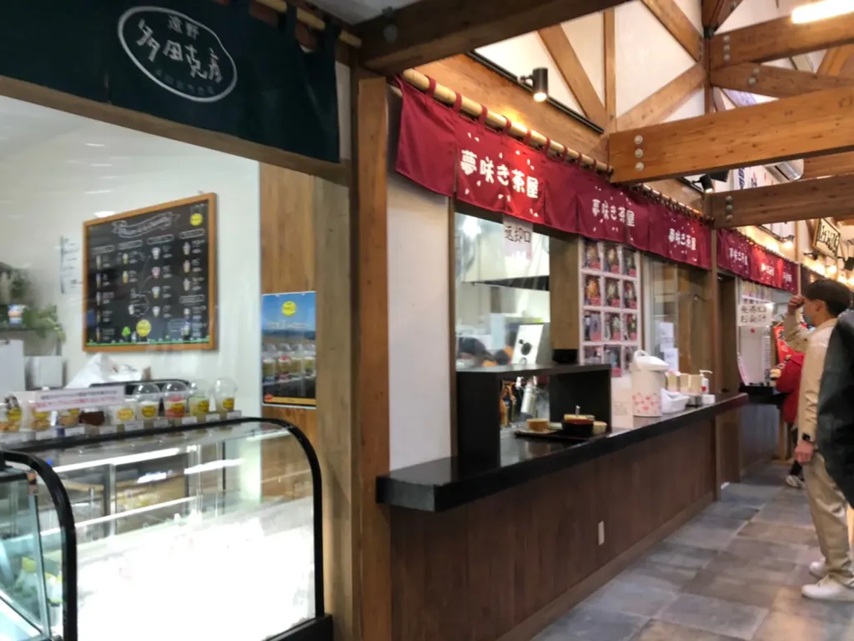
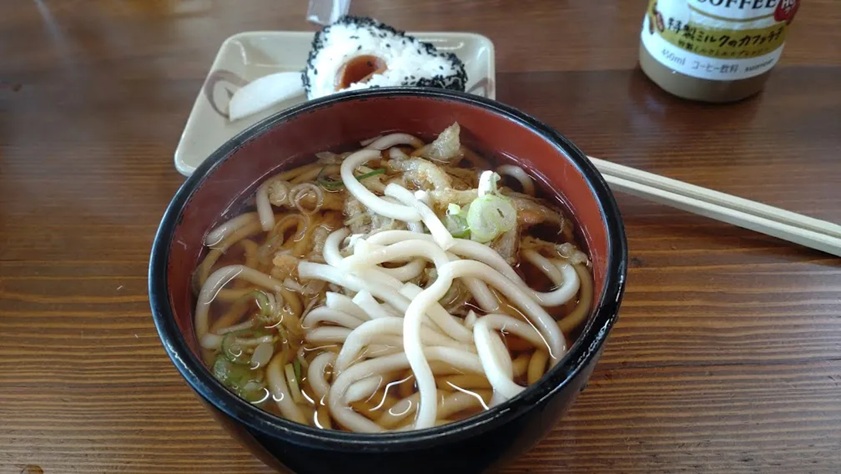
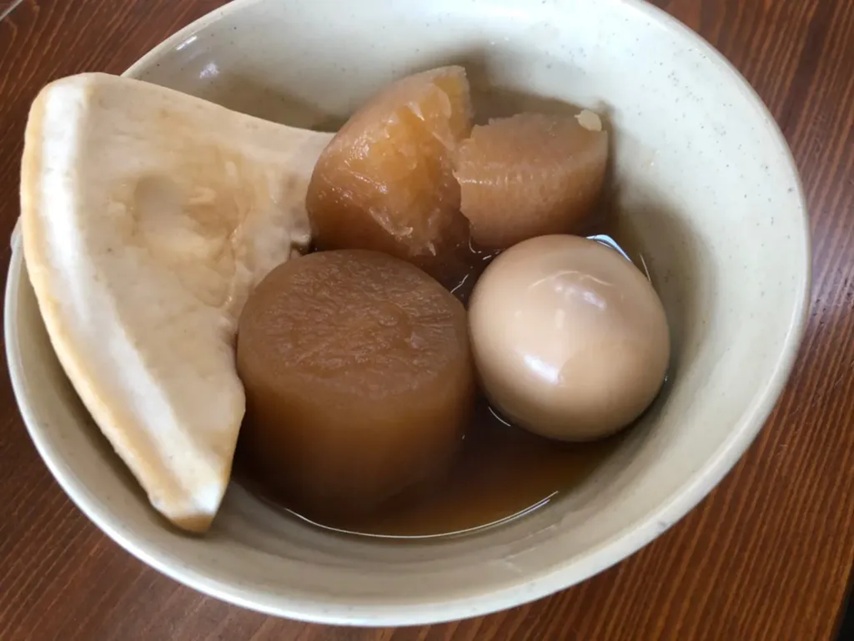
Udon alone would’ve done the trick, but the place was absolutely packed – no chance of grabbing a seat.
Managed to snag one eventually and went for oden, something I could eat right away.
Carb-heavy meal to keep the engine revving.
Also, thank god for those disposable heating pads – slapped one onto my back for good measure.
Tōno City to Kuzumaki Town.
Just as the sky was starting to clear up, I hit the road again, but guess what—hail.
And not just a little sprinkle, but a full-on hailstorm.
Forget the earlier rain—this was monsoon level downpour.
I decided to duck into a gas station to refuel and take shelter.
Turned out I wasn’t the only one with that idea—a whole gang of Harley riders on a group tour had the same plan.
Great minds think alike, I guess.
Before finding this gas station, though, I had tried another spot first.
To my surprise, they only had regular gasoline and diesel.
Kind of a classic “small-town gas station” situation, but didn’t expect it right in the middle of town.
My Mikuni TM38 carb gets around 17 km per liter when cruising and touring.
After about 250 km, I usually end up hitting reserve.
When I’m in unfamiliar areas, I make it a habit to refuel every 200 km just to be safe.
After that, I pushed on northward on Route 340, heading through the foothills of Mount Hayachine.
Despite being a national highway, it felt more like a country backroad winding through fields and streams.
Almost no traffic lights, so it’s pretty much a straight shot without any stop-and-go.
Normally, this would’ve been prime time for humming along and enjoying the ride, but… it was just too cold.
And I mean bone-chilling cold.
Spoiler alert—this won’t be the last time I say “cold” on this trip.
By the time I made it to Kuzumaki Town around 4 PM, I was shivering uncontrollably.
From Kuzumaki Town to Campground
One of my little camping pleasures is seeking out “famous water” or natural springs.
If there’s a spot like that along the way, I just have to stop by.
This time, the spring of choice was “Basho no Izumi.”
It’s tucked away in the mountains, just a short drive off Route 340 in Kunohe Village onto Prefectural Road 272 (Todanikarube Line).
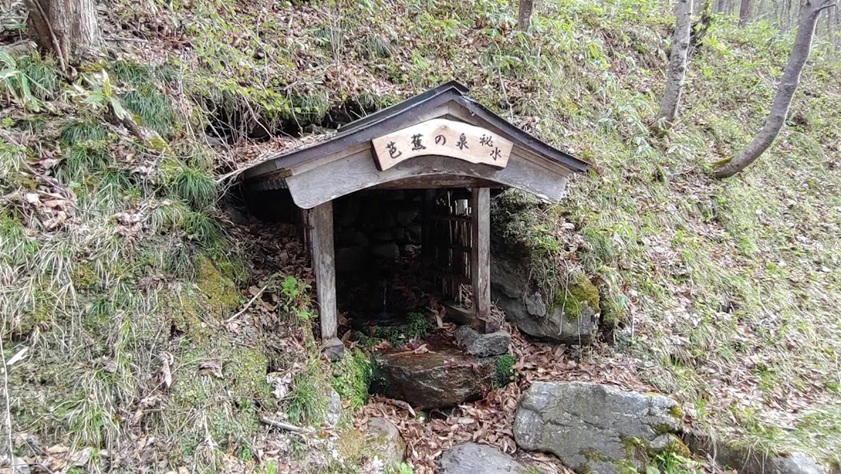
Unlike the typical famous springs bustling with visitors, this one had a quiet, hidden charm—like a secret only the locals know about.
After filling up my bottles for tonight’s dinner and tomorrow’s breakfast, I headed back to the main road.
Once I was back, I couldn’t resist taking a quick commemorative photo before moving on.
By the time I finally reached the campground, the evening shadows were already creeping in. Dragging my tired body to the reception, I was greeted with the dreaded words:
“There’s no reservation under your name.”
Just as I was about to pull up my confirmation email, I noticed a missed call from a number with an Aomori area code. Probably from the campground, wondering where the heck I was.
The staff at reception noticed too and said,
“Oh look, you’ve even got a call from the campground. Maybe there was a mix-up. The management office is up the hill, you might want to check there.”
So, I trudged uphill to the management building, only to find it completely shuttered and lifeless. Knocked on the door—no response. I called the number back, and a confused voice on the other end asked,
“Where are you now? Have you arrived?”
“Yeah, I’m right in front of the general information center. You’ll see a bike.”
“A bike? What does the sign say?”
“Uh… it says ‘Nagawawa General Information Center’ or something.”
“Wait… that’s in Nanbu Town, right? We’re in Shingo Village.”
“Wait… what? You mean I’m in the wrong place?”
“Yep, totally different spot.”
Oh. My. God.
Panicked, I checked the reservation email—and sure enough, the name was completely different from what I had in mind.
While browsing the reservation site, I had spotted an appealing campground but found it fully booked. So I hunted for alternatives and snagged the only open spot I could find. Somehow, my brain decided that meant I was going to the nice campground I originally wanted. What a blunder…
“So… how far apart are they?”
“Well, about 40 to 45 minutes by car. Maybe up to an hour, depending.”
“Right. I’ll head over now.”
“We’ll be closing up, but just let yourself in and settle down for the night. You can pay in the morning.”
Absolute legends! So kind!
With the accommodation secured, I swung by a nearby supermarket to grab supplies.
Nothing fancy—just some pre-cooked seasoned beef intestines and instant noodles. It was so cold that I couldn’t even bring myself to buy booze (ha!).
Back on the road, I rode along Route 454 towards Lake Towada.
Finally—finally—I made it to Maginohira Green Park Auto Campground in Shingo Village, Aomori.
It’s about a 30-minute drive from Lake Towada, and the campground is tucked behind a quaint little roadside station.
From above, it looks something like this.
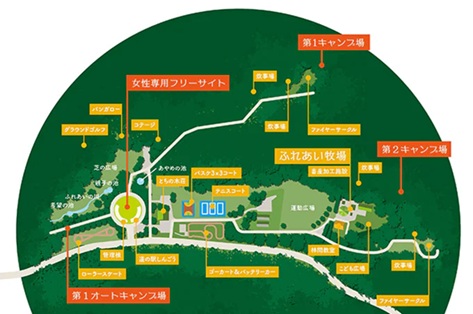
I stayed at the First Campground, which is the farthest one back.
The road eventually turns into a soft, unpaved path, so gunning it too hard can easily send you sliding.
Not to mention, it’s just good manners to ride gently so you don’t annoy other campers.
So, keep it smooth and steady—no need to channel your inner dirt truck rider here!
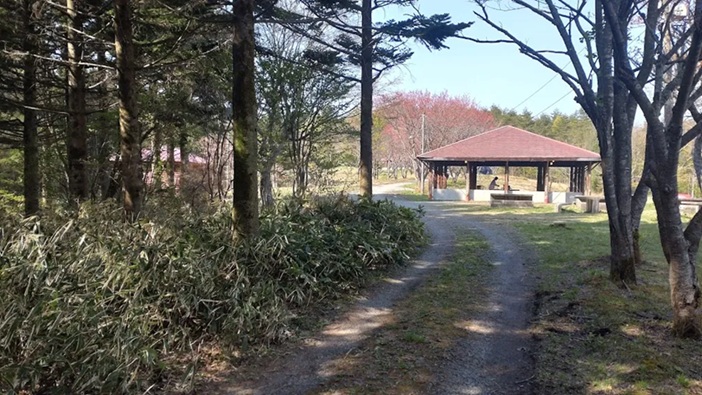
Last year, when I stayed at an auto campground on the Oga Peninsula, it was absolutely packed with people.
So this time, being Golden Week with no travel restrictions, I was half-expecting the free campsite to be crammed elbow-to-elbow with fellow campers.
But, to my surprise, it wasn’t nearly as crowded as I feared.
For riders worried about security, it’s a huge relief to be able to park your bike right next to your tent.
I set up camp before the sun completely disappeared and got right to work preparing dinner.
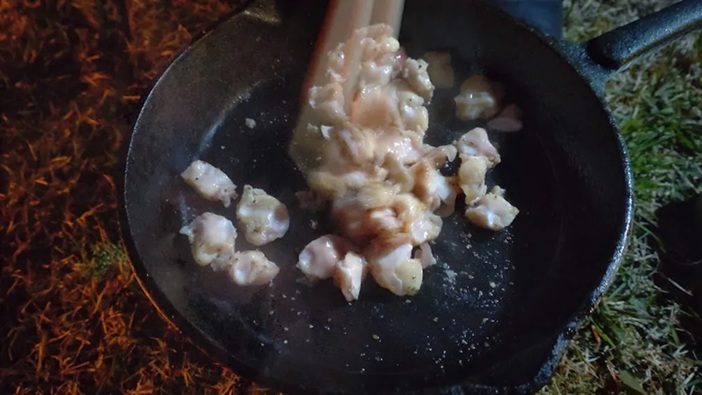
Dinner was my usual simple setup—grilling some miso-marinated pork intestines and cooking up a pot of rice.
Normally, that would be enough to put me in a great mood, but the relentless cold had other plans.
I ended up wolfing down my meal as fast as I could and calling it a night.
Since the First Campground doesn’t have showers, I just crawled straight into my sleeping bag.
And let me tell you, it was brutally cold. I kept waking up every hour, shivering and checking my watch like,
“Is it morning yet?”
Yeah… not exactly a restful night.
If it weren’t for that whole rain shelter mix-up, I could have arrived a good hour and a half earlier.
Turns out there’s a hot spring about 10 kilometers from the campsite—open until 9 PM, no less!
The legendary Washinoyu Shingo Onsenkan and Nozawa Onsen.
But, of course, I was practically running on fumes by the time I got to the campsite, so it was nothing short of a miracle I made it at all.
Such a waste… I’ll definitely have to come back someday to settle the score!
When morning finally broke, it was still cold enough to make me hesitate about packing up.
Usually, I’d be up early and getting ready to hit the road, but…
“Well, can’t pay the camping fee until reception opens, right?”
So, I just kind of lazed around, soaking up whatever weak sunlight broke through the morning chill.
Eventually, the cold eased up a bit, but then the wind kicked in with a vengeance.
Even with a disposable heat pad stuck to my back, the cold still won the battle, so I just stayed in the tent for breakfast.
Nothing fancy—fried up an egg and paired it with a cup of instant noodles.
Yep, breakfast of champions.
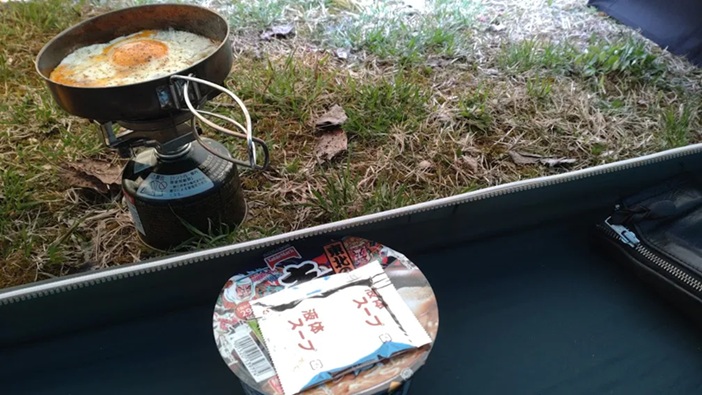
Cooking inside a tent? Yeah… way riskier than you’d think.
Nobody in their right mind would use a gasoline stove in there (I hope), but even with a gas stove, if you don’t preheat it properly, you might end up with a sudden flare-up.
Next thing you know, your tent’s doing its best impression of a bonfire.
That’s why I always cook in the vestibule area, just like in the photo—setting down the pot or pan before lighting the stove.
Sure, the flame might spread sideways, but that’s still way better than shooting a fireball straight up.
And then there’s the oil splatter problem.
For the sake of the photo, I didn’t bother covering the pan, but usually, I’d throw on a lid or wrap it with aluminum foil to keep the hot oil from making a mess.
One wrong splash and your tent might end up looking like it survived a food fight.
Now, eating in a cramped tent? That’s just asking for trouble.
Like in the photo where I brilliantly knocked over my ramen bowl…
To avoid turning the tent into a noodle graveyard, it’s smart to lay down a mat or just eat outside if you can.
Less mess, less stress.
If you do end up with a dirty or wet tent, congrats—you just scored yourself a packing nightmare.
And if you’re too lazy to clean it up before heading home, well, future you is gonna hate past you.
Honestly, putting in a little effort to keep things tidy at the start will save you a ton of headaches later.
Kinda like bike maintenance, right?
Do it right from the get-go and you’ll thank yourself later.
From Shingo Village to Christ’s Grave to Hachinohe City
By the time I finished breakfast, the temperature had finally started to climb.
Maybe it was the early summer dryness, but both the tent and the flysheet were bone dry—no dew at all.
I packed up in record time, thanked the staff at reception, paid the fee, and hit the road.
And guess what? The temperature had shot up to over 20°C.
Last night’s bone-chilling 7 or 8 degrees—what was that about? (Seriously, though… what the heck?)
Now, about last night—on my way here, I spotted something pretty intriguing.
Two things, actually: Oishi Shrine Pyramid and… wait for it… Christ’s Grave.
Or more accurately, the Christ Legend Village Museum.
I’d heard rumors before about there being a “Christ’s Grave” in Aomori, but I never thought I’d just stumble upon it on my route.
According to the Shingo Village website:
“Based on the Takeuchi Monjo (ancient manuscripts), it is said that there are seven pyramids in Japan, dating back tens of thousands of years—older than the Egyptian pyramids.
One of them, the Towarisan Pyramid, was discovered in 1935 by painter Hansan Toritani.
It is considered the fourth of these ancient pyramids, utilizing the natural mountain shape with massive stones arranged at the summit.
It is thought to have been used as a solar worship site since ancient times.”
Fifty thousand years ago? How many people even lived in Japan back then?
If I start talking like Professor O-Tsuki, I’ll never stop, so let’s just call it “romantic speculation” and leave it at that. (Gotta love a good historical mystery!)
But to be honest, the Christ Legend Village Museum sounds way more intriguing than the pyramid itself.
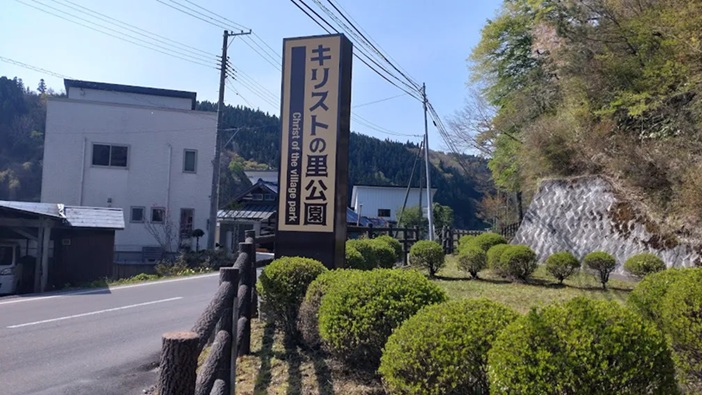
Amid the idyllic countryside, suddenly—bam!—an ominous, occult-scented sign appears out of nowhere.
And, of course, it absolutely delivers on that creepy vibe.
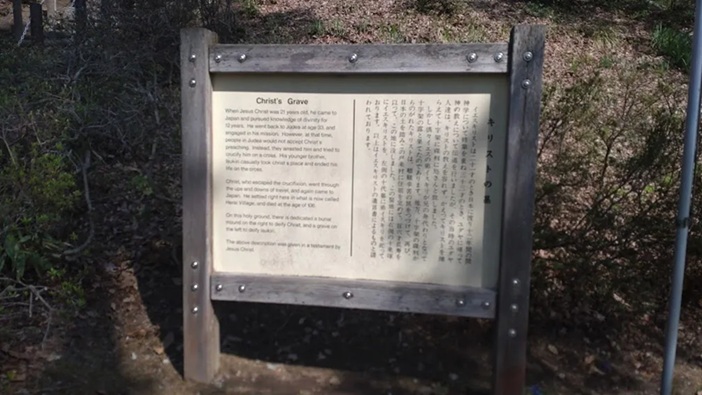
On top of a gently sloping hill sits the “Christ’s Grave”—complete with an explanation board that reads like something straight out of a conspiracy theory manual.
Here’s the gist:
When Jesus Christ was 21 years old, he traveled to Japan and spent the next 12 years training here.
After returning to his homeland at age 33 to begin his ministry, he was rejected by the Jewish people and sentenced to execution.
But—plot twist—it wasn’t Jesus who got crucified. It was his younger brother, Isukiri, who took his place.
Jesus himself managed to escape and made his way back to Japan, eventually settling in Herai Village (which, by the way, supposedly comes from “Hebrew”).
There, he lived to the ripe old age of 106.
Yep, that’s the story.
A theory as wild as the pyramid one—maybe even wilder.
You’d think such an outrageous claim would have devout Catholics or people from Israel fuming with rage… but surprisingly, not so much.
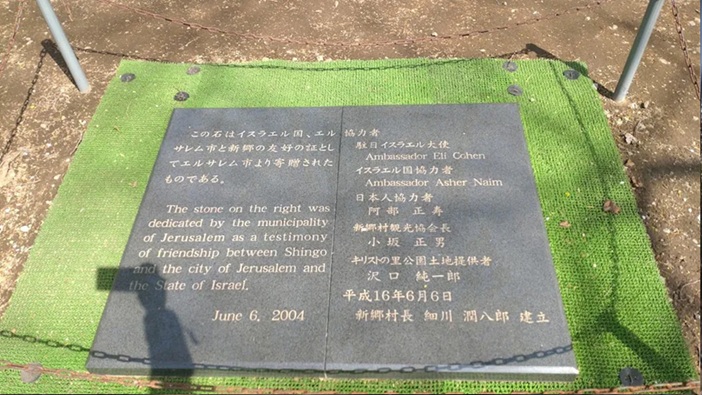
They actually have a friendship relationship with Jerusalem…!!
Way to go, Shingo Village!!
Absolutely legendary!
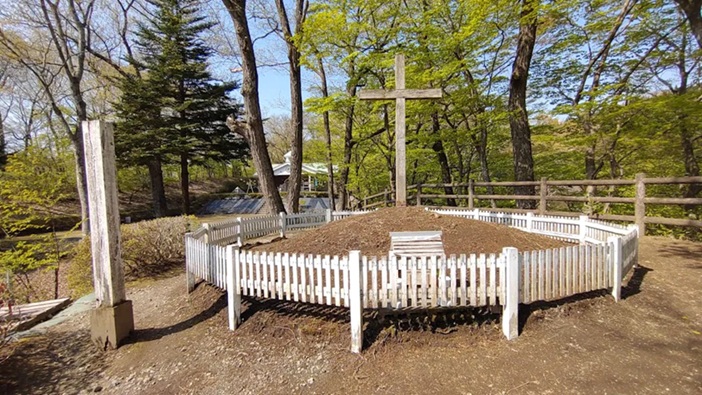
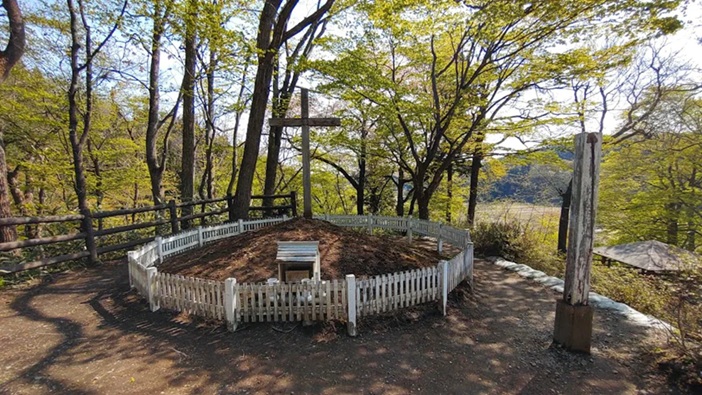
The graves of Jesus Christ and Isukiri.
Are they truly the resting places of the sons of God?
Or even real graves at all? Who knows.
But hey, whoever’s buried here—just keep watching over us foolish humans, will you?
The weather was absolutely perfect—clear skies and warm enough to unzip my jacket without a second thought.
But man, the wind was insane that day.
Even while waiting at a red light, sudden gusts kept slamming into me, giving me a bit of a scare.
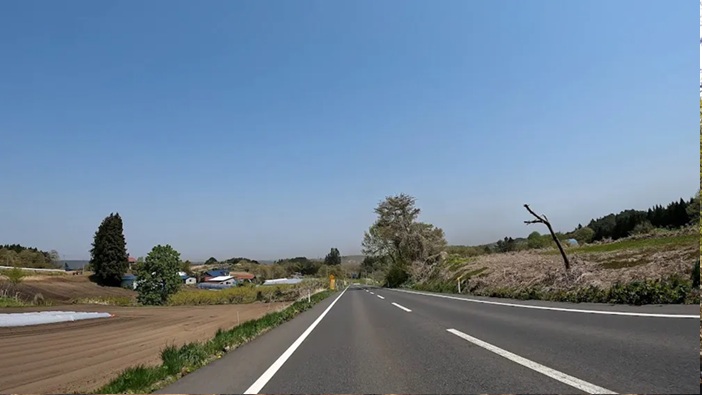
The original plan was to head out at the crack of dawn, grab some fresh seafood in Hachinohe, or maybe even push on to Misawa to take in the American-style streets.
But as you know, my departure got delayed, and on top of that, some urgent business popped up that needed sorting out by evening.
So, I settled for just a quick stop at Ashigezaki Observatory to take in the view.
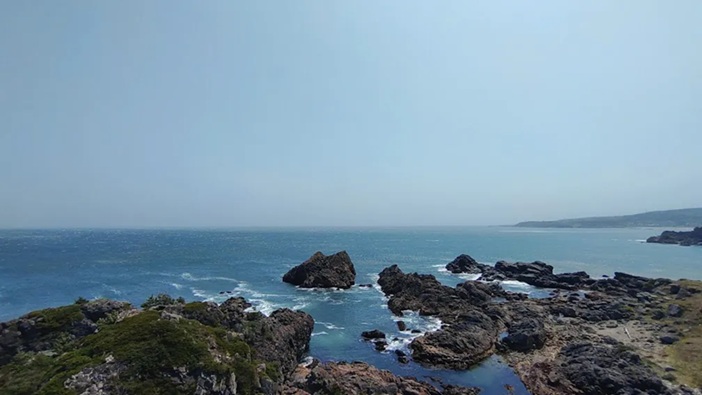
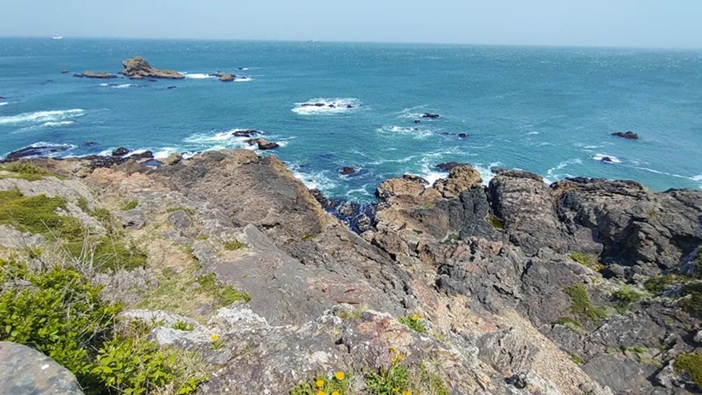
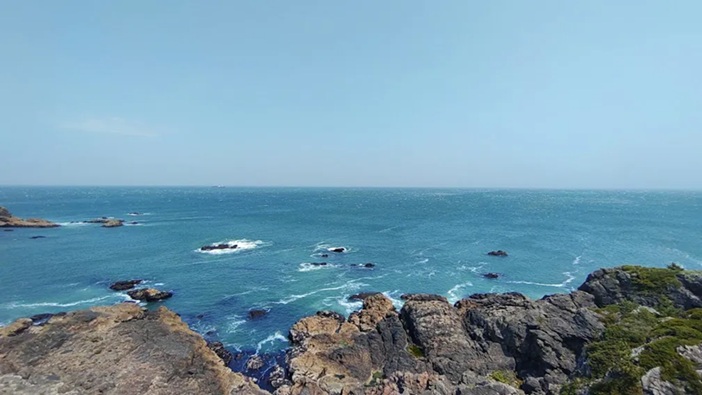
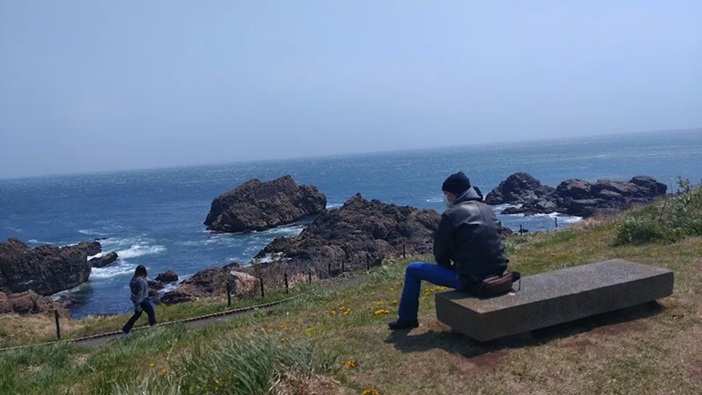
The view from Ashigezaki Observatory was absolutely stunning—a sweeping panorama of the Pacific Ocean.
But the wind was so fierce, I could barely stay on my feet.
No time to soak in the beauty—I just had to pack up and get out of there.
Next stop was Kabushima Shrine.
I’ve been to Hachinohe a few times for work, but somehow, I never even noticed it was there.
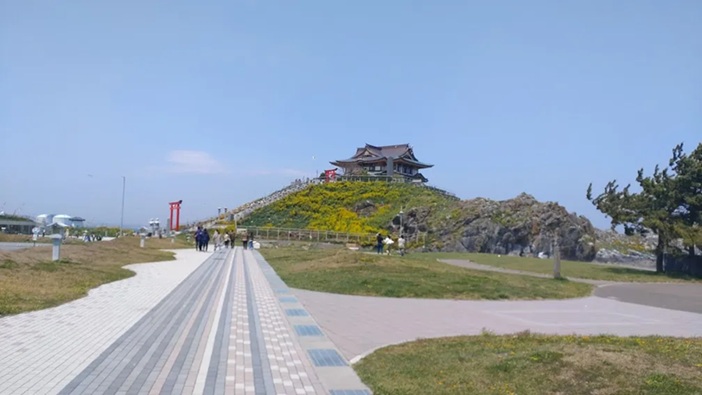
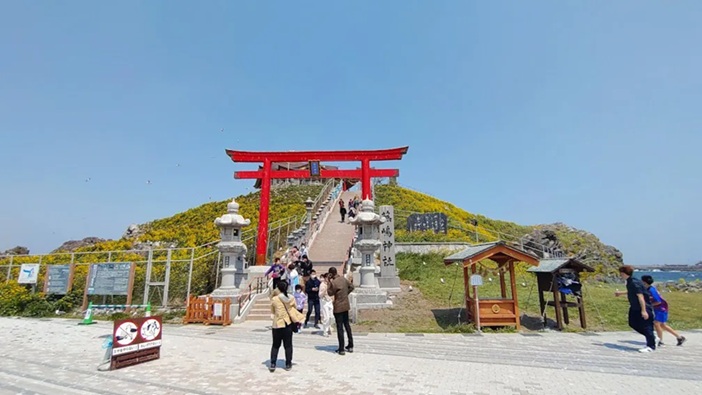
Maybe it’s just personal preference, but honestly, I think the best way to appreciate Kabushima Shrine is from above on the Umineko Line.
There’s something about that bird’s-eye view that really captures the strange charm of the place.
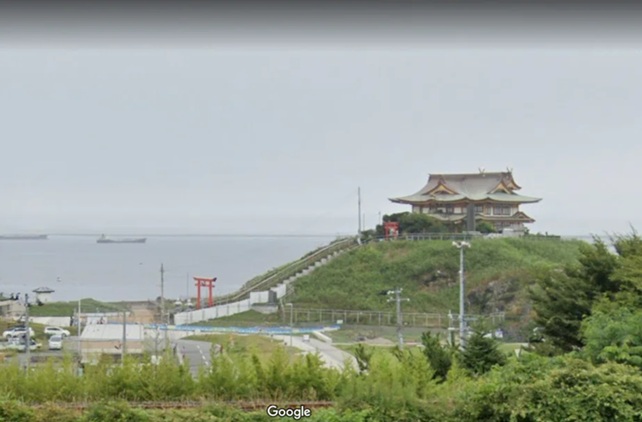
I glanced at the clock—11:30.
Ideally, I would’ve headed back to Hachinohe City for a nice meal before going home.
But even if I rode non-stop from here, I wouldn’t get back until after 4 PM.
Cutting it way too close.
So, I made a quick stop at Kabūnya, the local souvenir shop at Kabushima, to pick up a few small goodies.
Then it was back on the Sanriku Expressway, aiming for Miyagi Prefecture.
From Hachinohe City to Otsuchi Town
Since it was smack in the middle of Golden Week, the Sanriku Expressway was slow in places—not unexpected.
But honestly, that wasn’t the real problem.
The real nightmare was the insane wind.
Gale-force winds, violent gusts, sudden squalls—you name it.
I saw signs here and there showing wind speeds of 7 m/s and 8 m/s, but it felt more like a full-blown typhoon.
Yesterday, I was stiff from the cold—today, I was tense from sheer terror.
When it gets that bad, it’s crucial to consciously relax your upper body.
The instinct is to tense up, but that just makes it harder to keep control.
After about 200 km of battling the wind, I was physically and mentally exhausted.
It wasn’t even that I was hungry—I just desperately needed to get off the bike and ditch the helmet for a bit.
So, I pulled off the expressway and headed into Otsuchi Town in Iwate Prefecture.
By the time I rolled into town, lunch hour had already passed.
But hey, it’s Golden Week—places should still be open, right?
I headed toward the station and spotted the Sanriku Yatai Mura Otsuchi Marumaru Yokocho.
Looked promising—a bunch of little stalls with all kinds of food… or so I thought.
Turns out, the only place actually open was a ramen shop.
Not exactly the lively food scene I imagined.
A bit bewildered, I decided to try my luck somewhere else.
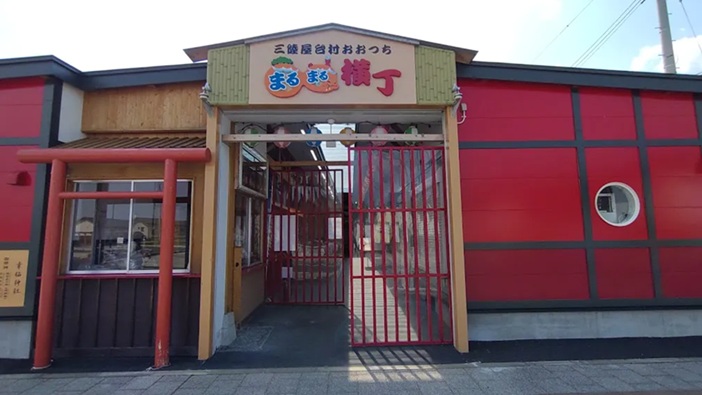
As I walked around in front of the station, I spotted a place that looked like a ramen shop.
The sign read “Mensho Tokishirazu”—seemed like that was the name.
Might as well check it out!
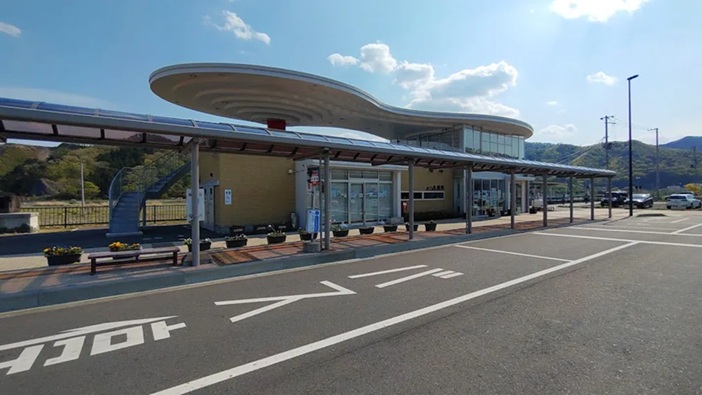
I ordered the Niboshi Ramen.
Light and refreshing, but still packed with umami—none of that weak, watered-down flavor here.
It hit the spot, soaking into my worn-out body like pure comfort in a bowl.
Before I knew it, I’d polished it off completely.
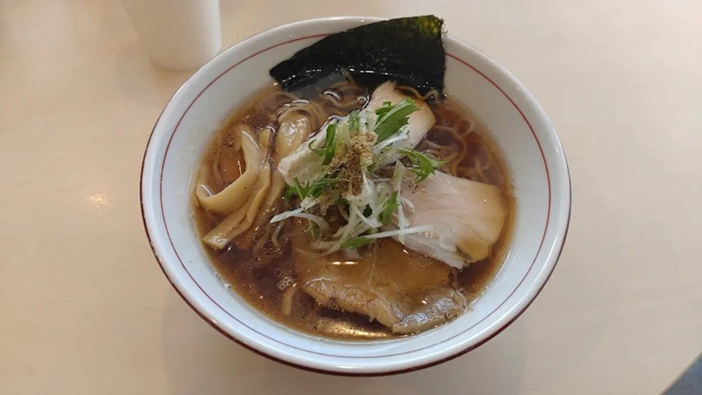
I’ve been to Yamada Town to the north and Kamaishi City to the south for work before, but I’ve never really had the chance to explore Otsuchi Town properly.
This time, it ended up being just a quick stop for a late lunch and refueling.
Next time, though, I’d like to take my time and see a bit more of the place.
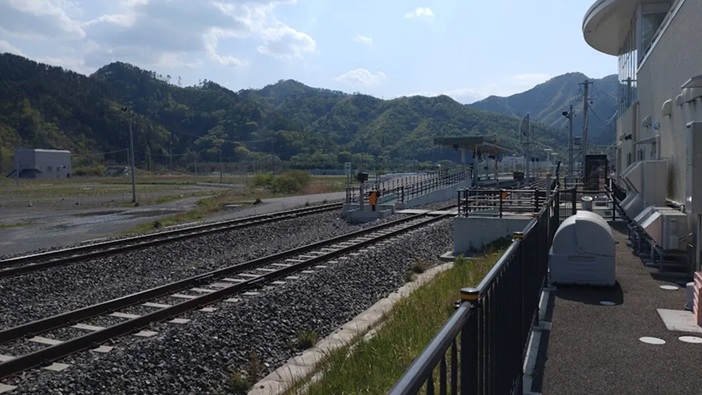
From Otsuchi Town to Home
About 200 km left to home.
I’d filled up on ramen, so all that was left was to cruise on back—smooth and steady.
Looked like I was finally in for an uneventful ride home.
But of course, fate had other plans.
Suddenly, I noticed something odd—just a faint “catch” when I twisted the throttle.
With the wind howling past, it had been hard to notice, but now it was unmistakable.
It wasn’t as bad as a full misfire or afterfire, but it felt off—like a carburetor setup that’s just a bit out of whack.
If the engine died here… that would be game over.
Seriously… this is bad.
It’s one thing to get stuck on an EV scooter—at least you can push it—but with a reciprocating engine, once it’s dead, it’s not coming back on the side of the road.
So, I just kept rolling south, twisting the throttle like I was praying to the bike gods.
And wouldn’t you know it—just when you’re on edge like that, things tend to get worse.
Sure enough, I hit the infamous Golden Week traffic jam.
For the first time ever (outside of road closures due to accidents), I actually had to put my feet down on the highway.
Somewhere past Kesennuma, Google-sensei popped up with,
“You might want to get off and take the local roads.”
Alright then, so I got off around Shizugawa and hopped onto Route 45.
Now, the problem with regular roads is the constant stop-and-go, which means the engine revs up and down—a perfect recipe for stalling.
Surprisingly, though, the lower rev range felt more stable and less prone to hiccups.
Guess I lucked out with that one.
Just as I was getting comfortable with the backroads, Google-sensei chimed in again:
“You should get back on the highway.”
Yeah, sure. But as I looked up at the parallel highway from the local road, it was barely crawling.
“You sure about that, Google-sensei?”
But hey, I decided to trust the algorithm and hopped back onto the expressway.
And guess what—just as I merged, the traffic jam dissolved like it was never even there.
The flow was smooth and easy. Damn, Google-sensei, you actually did it!
It got me thinking—maybe that’s how Ukraine holds its own against Russia—drawing strength from American IT know-how.
Somehow, with all that chaos and musings swirling in my head, I managed to make it home around 5 PM.
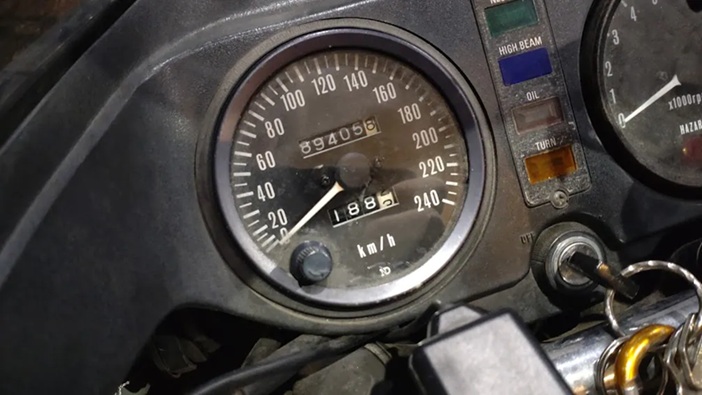
The odometer read 88,553 km when I set out, and 89,405 km when I got back home.
All in all, it was an 852 km journey.
Not too shabby for a Golden Week adventure!
Cause of the Trouble
The next day, once the engine had cooled down, I got right to work checking the spark plugs.
Come to think of it, last year during Golden Week, after riding over 600 km in a day, the engine just went completely silent—wouldn’t start at all.
I wondered how it would be this time.
With a bit of trepidation, I turned the key and fired it up—and surprisingly, it started without a hitch.
Alright, time to take a closer look at the plugs.
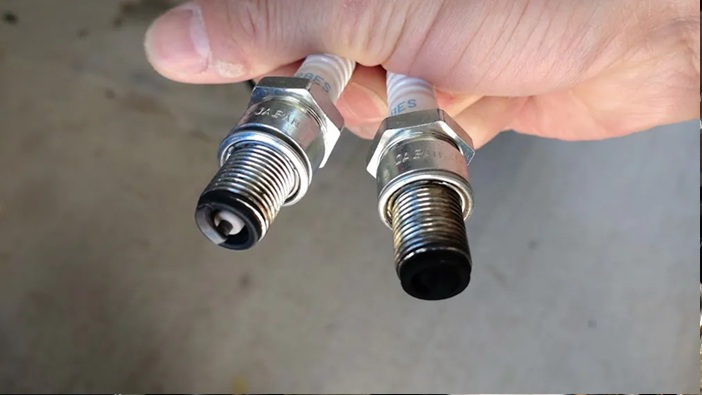
Only the #1 cylinder plug was completely charred—pitch black.
What the heck? Too rich on the fuel mix, maybe?
For now, I decided to lean out the pilot screw a bit (tightening it half a turn plus a tiny bit more) and see how that works.
Later on, when I took the carburetor apart, I found the problem—
the nozzle guide on the #1 carb had come loose and popped right out. (Whoops!)
Looks like I didn’t tighten it enough when I swapped it out.
Lesson learned—gotta double-check those fittings next time!
And then there was this problem…
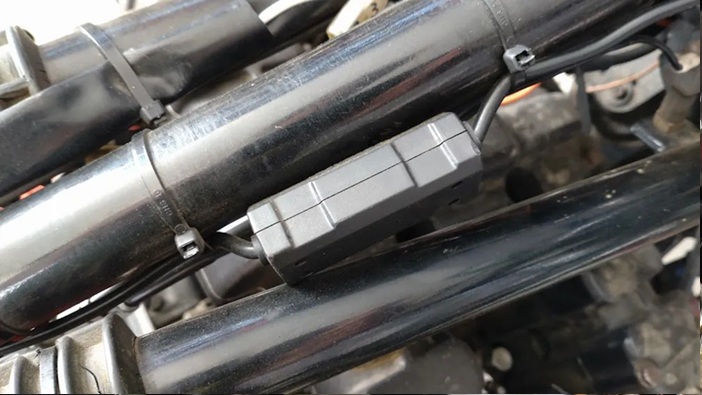
The crucial part of the USB power port setup—this little guy right here.
After using it for long periods, it just stops charging altogether.
I’m guessing it’s due to the heat from the cylinder head, but I can’t be sure.
Maybe I should extend the wiring and tuck it inside the cowling to keep it cooler…
Definitely something to think about before the next long ride.


コメント